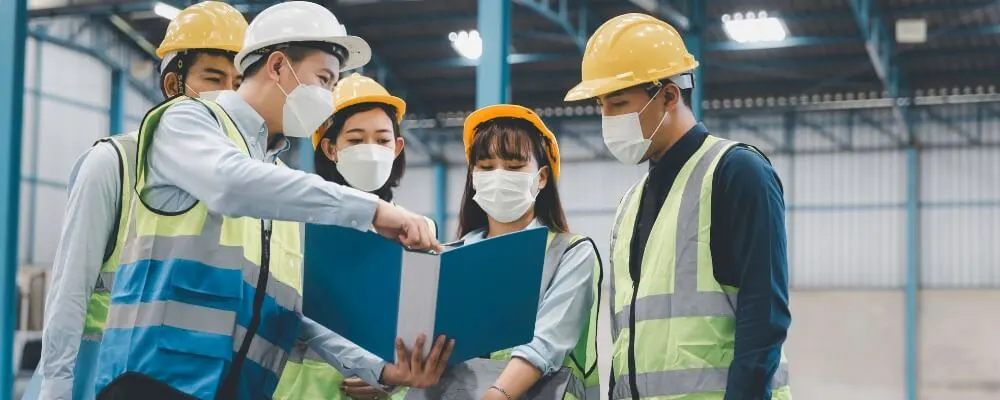Safety Moments are powerful tools to foster a culture of safety and mindfulness in the workplace, and their importance cannot be overstated. Maintaining a safe and secure environment for all team members is critical as we dive headfirst into our demanding work lives. A Safety Moment can be implemented at any time or place within the work setting through brief, focused conversations on safety.
In this blog post, we aim to demystify the concept of the Safety Moment, shedding light on its purpose, importance, and the considerable benefits it brings to the table. We’ll also delve into various engaging Safety Moment ideas and topics, spanning various industries and roles, to provide you with a toolkit for creating impactful safety discussions. Moreover, we’ll share numerous practical examples to assist you in designing effective Safety Moments for your organization.
Safety should remain at the forefront regardless of the nature of your team’s work. Our comprehensive guide to Safety Moments is designed to aid you in making safety an integral component of your daily work dialogues. So, let’s begin this journey toward creating a safer, more mindful workspace!

What’s Safety Moment?
A safety moment, sometimes also known as a safety briefing or a safety talk, is a short discussion or presentation on a particular aspect of health and safety in the workplace. This can include topics such as proper use of equipment, recognizing and avoiding specific hazards, or procedures for responding to emergencies. The primary purpose of a safety moment is to reinforce safety practices and create awareness among workers about the importance of safety and how they can prevent accidents and injuries during their work.
These briefings typically last a few minutes and are often conducted at the beginning of a meeting, shift, or workday. They can be led by a safety manager or any designated employee. They can be tailored to address specific safety concerns relevant to the work or tasks. By making safety moments routine, businesses can foster a strong safety culture, ensuring safety is at the forefront of everyone’s minds as they do their jobs.
Benefits Of Safety Moment
While short and seemingly simple, safety moments are critical aspects of any safety management strategy. Here are some of the key benefits they offer:
- Improved Safety Awareness: Safety moments help inculcate a habit of thinking about safety among employees, leading to increased awareness of potential risks and hazards. This can improve their capacity to identify unsafe conditions and prevent incidents before they occur.
- Promotes a Safety Culture: Regular safety moments can foster a culture of safety within an organization. They signal that the company takes safety seriously and expects its employees to do the same.
- Enhances Learning and Retention: Safety moments are brief and focused, so they can effectively convey and reinforce key safety principles without overwhelming employees with too much information.
- Encourages Engagement: By discussing real-life scenarios and encouraging employees to share their experiences and ideas, safety moments can engage employees more effectively than traditional safety training methods.
- Prevents Complacency: Regular reminders about safety can prevent employees from becoming complacent about potential risks, which is often when accidents happen.
- Reduces Accident Rates: Over time, all of these factors can contribute to a lower rate of accidents and injuries in the workplace, which benefits both employees and the organization.
- Compliance with Regulations: Many industries have regulations requiring regular safety training and awareness sessions. Conducting safety moments can be a part of meeting these requirements.
In sum, safety moments are key to promoting a safe work environment, encouraging good safety practices, and keeping safety in everyone’s mind.

Different Safety Moment Ideas and Examples
There are various safety moment ideas that you can discuss depending on your workplace environment. Here are a few ideas:
Remember, a safety moment is most effective when it is relevant to the specific workplace and tasks of the employees involved. It’s also helpful to encourage discussion and allow employees to share their experiences and ideas for improving safety.

Different Safety Moments Topics
Safety moments are versatile and can be adapted to any environment or industry. Here are some topics that you may want to consider:
Remember that the safety moment is most effective regarding a current situation or project. Tailor the content to the needs of your employees and the specific risks they face in their work.
Remember, these safety moments aim to prompt discussion and improve awareness of safety issues among your employees. Tailor these examples to fit your specific workplace and industry.

Tips On How To Conduct Effective Safety Moments
Effective safety moments require careful planning, relevant content, and thoughtful presentation. Here are some steps to guide you in doing so:
- Plan Ahead: Decide when and where you’ll conduct your safety moments. Most organizations do this at the beginning of meetings or shifts. You can rotate the responsibility among team members to ensure diverse perspectives and keep things fresh.
- Select Relevant Topics: Choose topics that are relevant to your work environment. This could be anything from safe lifting practices in a warehouse to maintaining hygiene in an office during flu season. The more applicable the topic is to your team’s daily work, the more likely they will remember and apply what they learn.
- Research Your Topic: Once you’ve chosen a topic, research it thoroughly. This could involve reviewing accident reports, examining chemical safety data sheets, consulting regulatory guidelines, etc.
- Prepare a Brief Presentation: Aim for a presentation that’s 5-10 minutes long. It should clearly explain the safety issue, why it matters, and what employees can do to protect themselves.
- Use Real-Life Examples: Where possible, include real-life examples or scenarios. This can help employees understand the practical implications of the safety moment.
- Encourage Participation: Make your safety moment interactive by asking questions or encouraging discussion. This makes the session more engaging and helps you gauge how well your team understands the topic.
- Follow Up: After the safety moment, consider sending a brief summary or reminder of the key points. This helps reinforce what was discussed and provides a reference for future use.
- Keep It Fresh: Don’t be afraid to change the format or content of your safety moments. Variety can keep employees engaged and make safety moments something they look forward to rather than a rote exercise.
- Evaluate Effectiveness: Regularly assess the effectiveness of your safety moments. Are accident rates going down? Are employees actively participating in safety moments and applying what they learn? Use this feedback to continuously improve your approach.
Remember, the goal of safety moments is to promote a culture of safety in the workplace, so it’s important to keep them engaging, relevant, and relatable.
Conclusion
In conclusion, Safety Moments are brief but crucial conversations promoting safety awareness and mindfulness in the workplace. By incorporating topics relevant to the organization’s operations, safety moments foster a work culture where safety becomes an intrinsic part of the daily routine. The variety of Safety Moment ideas, topics, and examples we’ve discussed in this blog post exemplify the versatility and importance of these discussions.
As we navigate our professional lives, it’s imperative to remember that safety isn’t merely a box to be checked off but a fundamental aspect that safeguards the well-being of every team member. Through these Safety Moments, we can stimulate dialogue, promote learning, and ultimately create a safer workspace.
Whether you’re new to the concept of Safety Moments or looking to enhance your existing safety program, we hope this guide has equipped you with fresh insights and ideas. Remember, the success of any Safety Moment lies in its relevance, simplicity, and engagement. So keep it specific, brief, and most importantly, safety at the forefront. Here’s to creating safer, more mindful work environments, one Safety Moment at a time.

